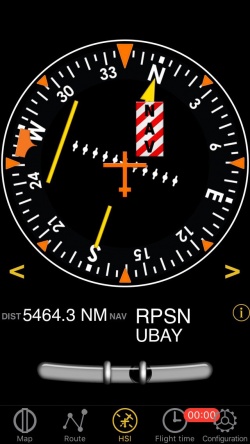(Created page with "La aguja amarilla es el apuntador de curso seleccionado (OBS); la parte móvil en el medio es el indicador de desviación (CDI), el cual exhibe la desviación (+/- 12 grados)...") |
(Created page with "A diferencia de un HSI real donde el apuntador de rumbo naranja es usado para establecer el curso para el piloto automático, el virtual muestra la dirección al waypoint sele...") |
||
| Line 8: | Line 8: | ||
La aguja amarilla es el apuntador de curso seleccionado (OBS); la parte móvil en el medio es el indicador de desviación (CDI), el cual exhibe la desviación (+/- 12 grados) desde la selección del radial o curso, hasta o desde un waypoint seleccionado. | La aguja amarilla es el apuntador de curso seleccionado (OBS); la parte móvil en el medio es el indicador de desviación (CDI), el cual exhibe la desviación (+/- 12 grados) desde la selección del radial o curso, hasta o desde un waypoint seleccionado. | ||
| − | + | A diferencia de un HSI real donde el apuntador de rumbo naranja es usado para establecer el curso para el piloto automático, el virtual muestra la dirección al waypoint seleccionado. Asimismo, el HSI no exhibe la dirección magnética sino el curso del avión. | |
The compass card will rotate automatically to match the current flying track. | The compass card will rotate automatically to match the current flying track. | ||
Revision as of 18:28, 4 November 2016
Air Navigation puede simular un HSI (Indicador de situación horizontal).
La aguja amarilla es el apuntador de curso seleccionado (OBS); la parte móvil en el medio es el indicador de desviación (CDI), el cual exhibe la desviación (+/- 12 grados) desde la selección del radial o curso, hasta o desde un waypoint seleccionado.
A diferencia de un HSI real donde el apuntador de rumbo naranja es usado para establecer el curso para el piloto automático, el virtual muestra la dirección al waypoint seleccionado. Asimismo, el HSI no exhibe la dirección magnética sino el curso del avión.
The compass card will rotate automatically to match the current flying track. Radial or course selection is done by touch and swipe gesture up or down on the left or right of the compass ring.
![]() A “NAV” warning flag will let you know that you should NOT trust the HSI indicator in the following cases:
A “NAV” warning flag will let you know that you should NOT trust the HSI indicator in the following cases:
- No waypoint is selected for the instrument;
- The waypoint distance is over 250 nautical miles;
- The GPS accuracy is bad;
- Ground speed is less than 5 Kts.
Note: Please note that you may still get correct deviation information when GPS accuracy is less than 2.5 nautical miles. In this case the compass card will be oriented to the north.
Below the main indicator, the selected waypoint is displayed as well as the distance from the waypoint (great circle distance) and GPS accuracy. You can use any kind of waypoint (Airports, VOR, NDB, etc) to be used with the HSI instrument. (A real HSI indicator requires radio signals from VOR, VOR/DME or VORTAC transmitters).
You can select a new waypoint from the database with the blue disclosure button at the bottom part of the instrument (see screenshot). Please read Search Module to get information about waypoint search and selection. (iOS version)
Note: remember that you will ONLY find the slipball at the bottom of the instrument on iPhone/iPod Touch devices.
Back to index (Android)
Back to previous page. (iOS)

